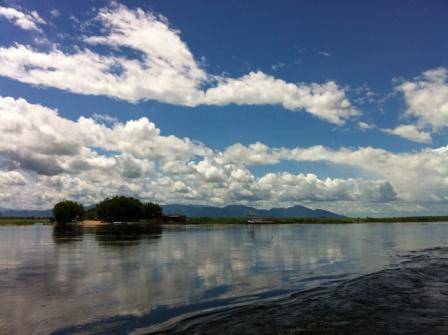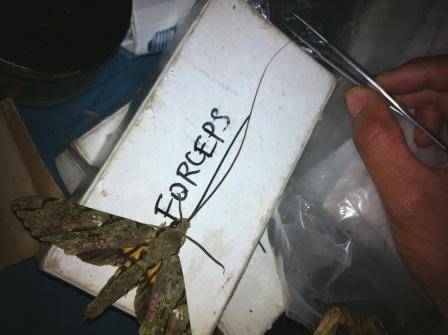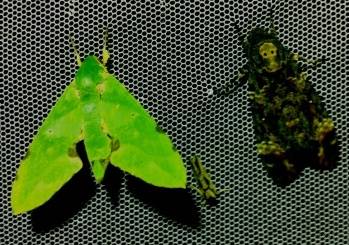Hello beetlers,
Here is the final instalment of HT's intrepid adventures in Africa. We shall be sorry there are no more tall tales from the interior, but happy to have him back in the Coleoptera fold, and even happier with the beetles he will return with for us!
This is quite a long entry, but it's worth it to read to the end and celebrate the Royal Wedding once more (any excuse, and remember, it's always cocktail hour somewhere in the world!) with Hitoshi and his fieldwork companion Ian...I think you will find what they get up to in this video installment quite revealing...and no skipping to the end! BG
Uluguru Mountains
Expeditions in remote parts of the world have their ups and downs, and inevitably, things do not go to plan according to your itinerary. On departing Mahenge, our journey up to the Uluguru Mountains was hampered by the crossing of the Kilombero River, something that was very simple on the way down. There is no bridge here and the only means of crossing is a short ferry ride. This crossing is also the route linking the capital Dar es Salaam and Malawi – this is the main road, an economic highway of significant importance. We arrived at the crossing after a long day’s drive from the mountains and found that the ferry had been out of service for four days and a long queue has formed - four day’s worth of vehicles waiting to cross! This, unsurprisingly, made the national news. Not much forethought went into the ferries and unfortunately the spare ferry was also broken. Typical. We were stuck.
Flooded Kilombero River
So to Plan B.
With nowhere else to go, we headed back south to a small piece of lowland forest called Nambiga, and camped by the side of the road. We don’t miss an opportunity for entomological collection and so up went the light trap right next to the vehicle! We attempted to cross the Kilombero in the morning but due to the incapacitated ferry, we took a small boat with all the kit across the swollen Kilombero and had another vehicle meet us on the other side.
This delay did at least allow us to watch the Royal Wedding on a tiny television screen in the only bar of a village in the middle of nowhere! It did however mean that we had to postpone the celebratory drinks planned for the forest until the following day. This did not matter too much – it gave us more time to secure the important gin.
If you are thinking that the last part of this trip has turned into one massive booze-up you would be extremely (well, partly) mistaken. There is still a lot of work to do.
Uluguru is an isolated set of mountains near the large town of Morogoro in the centre of the country. The close proximity of the forest to human habitation has meant that over the years, incredible amounts of deforestation has taken place and much of the forest has now disappeared. There are small pockets of intact forest left such as at Tegetero, the site of our research. Now, if you were wondering if I was going to make a comment on European architecture in Africa at this point, you will not be disappointed. The church and the mission at the village of Tegetero were built by the British in the 1940’s.
Church at Tegetero
The walk in was similar to the other mountains – farmland, scrub and then forest. Unfortunately, the local villagers have been using the forest as their local “supermarket” and according to the local forestry officer, all large ground dwelling mammals such as duiker, bushbuck and bush pig have been hunted out. Just a small population of Colobus monkeys is all that remains. Having said this we also encountered an extremely rare bird; the Uluguru Bush Shrike is only found in these mountains and it was actually rather common, their noisy calls being heard regularly.
The lack of large mammals also means a lack of dung. The dung baited pitfalls were pitiful and caught four beetles in the whole time we were here! We might as well have just stuck a few cups in the ground and hoped for the best.
General collection and beating have worked rather well, the latter producing some fine weevils. Some of the most beautiful beetles we have seen here have been the large black ground beetles with a green iridescence belonging to the genus Tefflus which I have not seen elsewhere. These voracious hunters are often found on the forest floor near water and exude a rather unpleasant smell when held.
Tefflus sp (Carabidae)
The MV bulb has worked better and on more than one occasion, we have had excellent nights with an incredible variety and number of moths. The hawkmoths are certainly some of my favourites and the species which have been turning up to the light have been spectacular. Pictured are Xanthopan morgani (with an incomprehensibly long proboscis), Euchloron megaera (left) and the Death’s Head Hawkmoth, Acherontia atropos (right).
Xanthopan morgani
Euchloron megaera (left) and the Death’s Head Hawkmoth, Acherontia atropos (right)
Yes, I know photos of moths on a beetle blog. My apologies. So to rectify the situation a beetle, Ceratocentrus spinicornis, that was also attracted to the light. As far as I can remember, the NHM collection does not have a single specimen of this species from East Africa.
Ceratocentrus spinicornis (Cerambycidae)
Apart from the aforementioned, it has been rather quiet on the beetle front. It just goes to show that seasons play an important role in the abundance of all insects here – when I was last here in November/December, the light traps would be covered in beetles, especially the Melolonthine scarabs. This time around, only a few individuals have been present.
Our nightly visitors to feast on the insect “buffet” that is the MV light here in the Ulugurus have included amongst others, bats, geckoes and this beautiful tree frog.
Tree frog of the genus Hyperolius
I now have a fellow wet season explorer with me on this expedition – Ian Baldwin, a contemporary of mine from university years and an aspiring wildlife cameraman, has been filming all entomological and expedition related activities for a short film later in the year. Watch this space!
The fieldwork will shortly be coming to an end. We will be heading back to Dar es Salaam, to the University to help stabilize their natural history collections and then home. London.
HT
A huge thank you to Hitoshi for sharing his trials and tribulations with us, and welcome back!
Next time, we are much closer to home with fieldwork at Bookham Common, where there are no monkeys. BG





